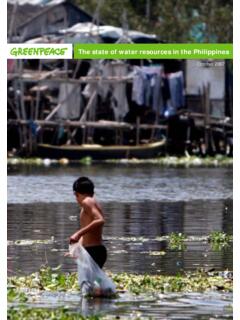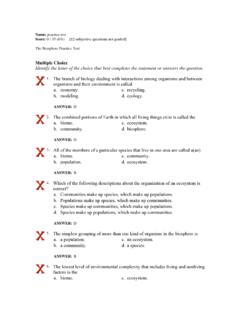Transcription of Eco System for Sustainable Living
1 Science for Sustainable LivingSub-theme: IEco System forSustainable LivingScience for Sustainable LivingScience for Sustainable LivingSub-theme: IEco System for Sustainable Living We cannot solve our problems with the same thinkingwe used when we created them. Albert Einstein Eco means natural habitat. The System for the existence of natural habitatof biological community (of organisms) interacting with their physicalenvironments is the ecosystem. It includes all the Living things (plants, animals,and organisms) in a given area that interact with each other, as well as with thenon- Living entities (weather, earth, sun, soil, climate, atmosphere, land) aroundthem.
2 The Living and non- Living ( physical) components are linked togetherthrough nutrient cycles and energy flows. All the plants and animals (both macroand micro) on the Earth rely on the respective ecosystems for food andhabitation. Therefore, the ecosystems must maintain a delicate balance inorder to stay vital. Human beings like other organism, also rely on ecosystemsto have food and natural resources. Depending on various characteristics, theeco- System has been classified primarily as Terrestrial and Aquatic; but there9 Science for Sustainable Livingare many sub-groups as shown in Box I & II.
3 It is to be understood, whennatural resources are harvested out of an ecosystem, it can disrupt thedelicate balance if not done in a rational and responsible way. Nevertheless,following diagram ( ) shows the different components of Different component of Types of Ecosystem10 Science for Sustainable LivingIndia has some of the world s most enriched ecological zones or eco-zones ,which has been depicted through ; and because of the country s diversephysical features and climatic conditions a variety of ecosystems haveresulted.
4 By and large these ecosystems harbour and sustain high biodiversityand contribute to overall well-being of man and animal. But, climate change,pollution and other environmental factors affect ecosystem processes (functionsand services) affecting Sustainable Living and livelihood. Critically,sustainability includes health of the land, air and sea. How Ecosystem Helps UsAn ecosystem provides habitat to wild plants and animals and supports differentfood chains and food webs. It regulates essential ecological processes and sup-ports lives.
5 It also helps in recycling of nutrients through biogeochemical cyclebetween biotic and abiotic components of the Earth. All these activities are termedas Ecosystem Functions. Fundamentally, the functions of ecosystem ( ) are exchange of energy and nutrients in the food chain, which sustain plantand animal life, including human being, on the planet. The decomposition oforganic matter and the production of biomass are also the result of ecosystemfunctions. These functions, within the ecosystem, help in maintaining Earth s natu-ral balance.
6 So, it is a vital pro-cess related to our , as a result suchfunctions the Living organismson the earth, including humanbeings, get benefit directly andindirectly from ecosystems inmany a ways and these ben-efits are known as EcosystemServices( ). The benefitsobtained from ecosystems canbe categorized as ProvisioningServices(also known as goods)such as food and water; Regu-Fig. Ecosystem functionsSunDecomposersConsumer-2(Small carnivours)3rd Tropic LevelConsumer-1(Herbivours)2nd Tropic LevelProducer(Green Plants)1st TrophicLevelConsumer-3(Large carnivours)4th Tropica LevelEcosystemfunction11 Science for Sustainable Livinglating Services such as flood, pest, anddisease; Cultural Services such as spiri-tual and recreational benefits; andSupporting Services such as nutrientcycling, soil formation, carbon seques-tration, primary production and somany.
7 These services of the ecosys-tems primarily are the result of interac-tion among soil, animals, plants, waterand air. The goods and services theyprovide are vital to sustaining not onlywell-being of society, but also vital tofuture economic and social develop-ment. It is to be noted by the beneficia-ries of any ecosystem that a healthyecosystem cleans our water, purifiesour air, maintains good health of oursoil, regulates climate, recycles nutri-ents and provides us food. They alsoprovide raw materials and resources forshelter, industry and many other pur-poses to cater our various needs.
8 Theyare the foundation of all civilisation andeconomic of Ecosystem DegradationHuman society is using the ecosystem resources for Living and livelihoodfrom time immemorial. Exploitation of natural resources is an essential condi-tion of human existence throughout the history of mankind. Humans have ex-ploited natural resources to produce the materials they needed to sustaingrowing human populations. But the way they use resources often provokes ir-reversible ecological change. According to the Millennium Ecosystem Assess-ment (MEA) sponsored by the United Nations, 60% of the ecosystems onEarth are being used up faster than they can replenish themselves.
9 Virtually,REGUALATING SERVICESB enefits obtained from the regulationof ecosystem processes Flood prevention Climate regulation Erosion control Control of pests and pathogensSUPPORTING SERVICESS ervices necessary for the production of all other ecosystem services Biological diversity maintenance Nutrient recycling Primary ProductivityCULTURAL SERVICESN omaterial benefits obtainedfrom ecosystems Educational Recreational Heritage SpiritualPROVISIONING SERVICESP roduct obtained from ecosystems Energy Seafood
10 Biomedical Transportation National Defense Ecosystem Services12 Science for Sustainable Livingthe degradation of ecosystems is an environmental problem that diminishes thecapacity of species to survive. This degradation occurs in different ways and ismanifested in a reduction in the richness of the ecosystems as well as theirbiological diversities, and also in the goods and services they can offer, therebyaffecting both indigenous and/or migratory species. The degradation of ecosys-tems due to overexploitation of their resources, though serving a short-termeconomic goal, has had direct negative effects on social welfare.






